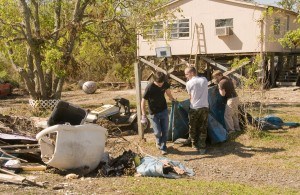The modest home on South Clover Street is, quite simply, a wreck.
Waist-high ragweed chokes front and back yards.
Rusting appliances and toys clutter the carport of the dilapidated structure, topped by a sagging patchwork of missing roofing tiles offering little protection from the elements.
Besides looking messy, the weedy lot provides habitat for snakes, rats and other vermin and the home attracts vandals and vagrants, neighbors say.
It’s been going downhill ever since Hurricane Ike flooded it with more than four feet of water on Sept. 13, 2008.

Bridge City residents S.E. and Bertha Werkheiser, who have lived next door to the house since the early 1960s, are sick and tired of putting up with it.
“It would be a blessing to have it torn down and cleaned up,” said Bertha Werkheiser, 77.
Bridge City officials said she might get her wish before long.
Code enforcement officer Clarence Philpott said he is preparing to make a presentation to the city housing board, the final step in condemning substandard properties before clearing the lots.
The problem isn’t huge, only about 125 houses out of about 3,000 in the small city, Philpott said.
But for neighborhoods riddled with these pockets of blight, it’s a daily headache.
Down the street on the other side of the block, another house sports a row of broken windows across the front – the handiwork of neighborhood kids, said Jim Torres, who owns the house next door.
However, this house doesn’t look quite as bad as the other one down the block because Torres has been mowing the lawn.
Torres led a brief tour of the two-bedroom house.
“Come on in, the door’s open,” he joked, stepping over piles of broken glass from an ornate leaded glass door that no longer provides a barrier to the street. Inside, garbage and debris are piled on the floor of a partially gutted kitchen.
The two bedrooms have had wallboard installed since the storm, showing evidence that renovation had begun at some point.
But work has ceased since then, and the house has been abandoned.
Lack of insurance and other financial problems often are the reason former residents walked away.
In some cases, elderly people simply took their insurance settlements and moved on, City Manager Jerry Jones said.
He said he regrets delays in tidying up the landscape.
“We would have already started, but we are a small city and don’t have a lot of manpower,” he said.
Jones said residents are responsible for repairs or demolition and clearing the lot, but the city will help if owners can’t afford it. The burden also falls on the city if officials can’t find the owners.
“We have programs for people if they need help,” he said, adding that the city is using inmate labor for the work.
“We have some money set aside for demolition of structures, but we’re going to try to keep costs way down,” Jones said.
Part of the delay lies in the legal process protecting the property owners’ rights, Philpott said, and steps must be followed before the lots can be cleared. A certified letter to the property owner comes first. If there is no response, the house is tagged as substandard.
After that, code enforcement brings the case to a board tasked with making the determination. If the owners can be found and are cooperative, the board will work with them as long as satisfactory progress is being made on repairs.
At least one vacant house on South Clover Street might fall into that category, with a tended lawn and evidence of recent renovation activity.
“We try to work with everybody,” Philpott said. “We do have some people that have walked away – we can’t even find them or what bank owns them.”
Philpott said more than 15 owners have come in and signed a release for demolition, which could start in about a month.
“We need to address those now,” Jones said. “We’re not trying to make it hard on people by any means, but it’s time to get everything cleaned up.”
The city will be working with property owners, using inmate labor and trying to make the process as inexpensive as possible for the small community.
Was this article valuable?
Here are more articles you may enjoy.

 Musk’s X Probed by UK Over Grok’s Thousands of Sexualized Images
Musk’s X Probed by UK Over Grok’s Thousands of Sexualized Images  Tesla, EEOC Plan Talks to Settle Factory Racism Suit
Tesla, EEOC Plan Talks to Settle Factory Racism Suit  Palantir Poaching Suit Called ‘Scare’ Tactic by Ex-Employees
Palantir Poaching Suit Called ‘Scare’ Tactic by Ex-Employees  NYC Sues Delivery App Over Lost Pay in New Mamdani Crackdown
NYC Sues Delivery App Over Lost Pay in New Mamdani Crackdown 